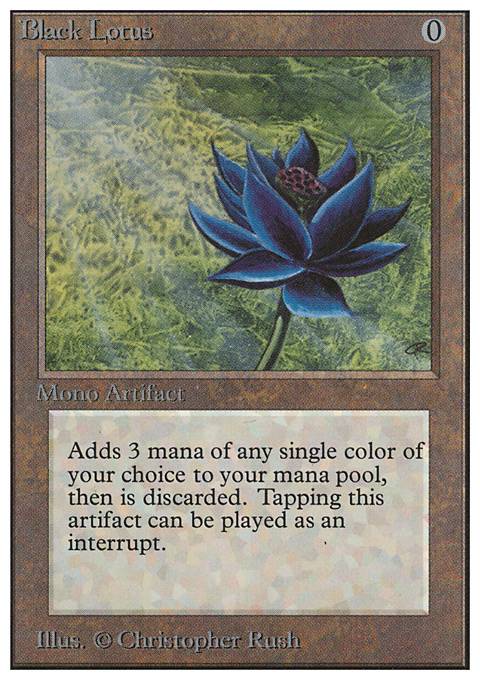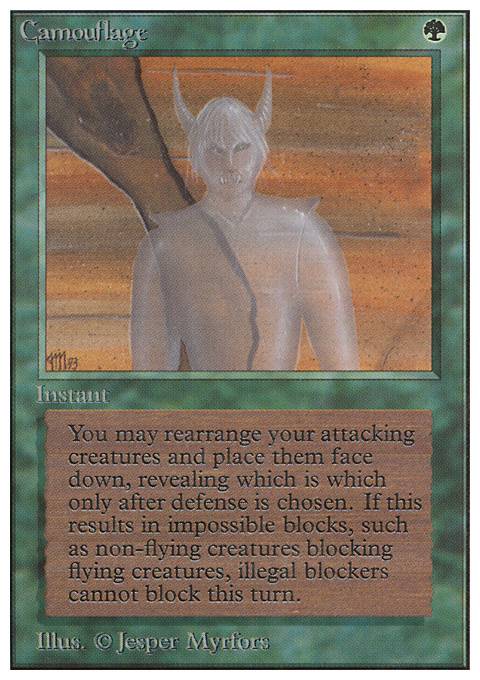
Combos Browse all Suggest
Legality
| Format | Legality |
| 1v1 Commander | Legal |
| Archenemy | Legal |
| Canadian Highlander | Legal |
| Casual | Legal |
| Commander / EDH | Legal |
| Commander: Rule 0 | Legal |
| Custom | Legal |
| Duel Commander | Legal |
| Highlander | Legal |
| Legacy | Legal |
| Leviathan | Legal |
| Limited | Legal |
| Oathbreaker | Legal |
| Oldschool 93/94 | Legal |
| Planechase | Legal |
| Quest Magic | Legal |
| Tiny Leaders | Legal |
| Vanguard | Legal |
| Vintage | Legal |
Camouflage
Instant
Cast Camouflage only during your declare attackers step.
This turn, instead of declaring blockers, each defending player chooses any number of creatures he or she controls and divides them into a number of piles equal to the number of attacking creatures for whom that player is the defending player. Creatures he or she controls that can block additional creatures may likewise be put into additional piles. Assign each pile to a different one of those attacking creatures at random. Each creature in a pile that can block the creature that pile is assigned to does so. (Piles can be empty.)
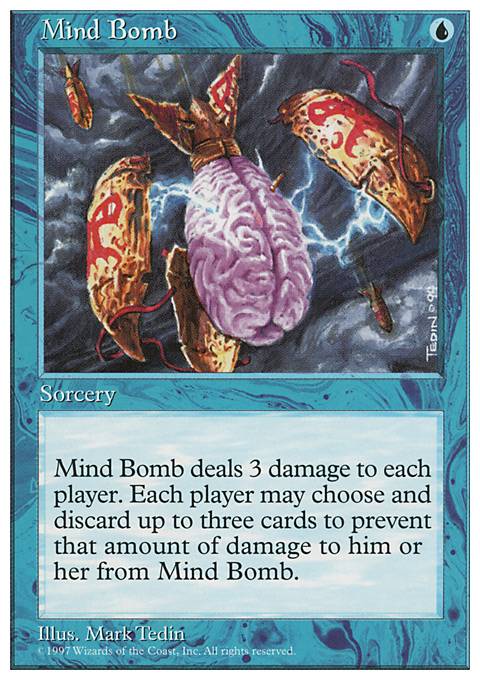
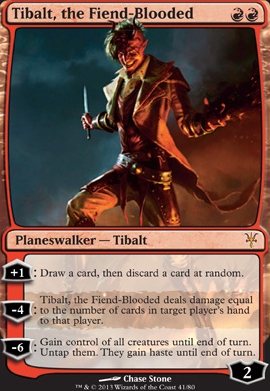
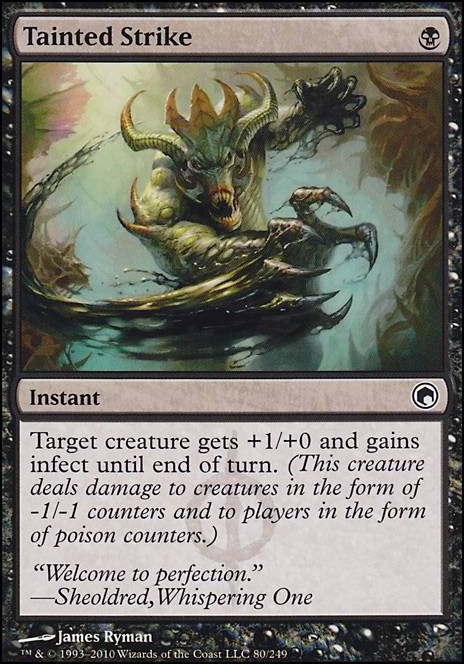
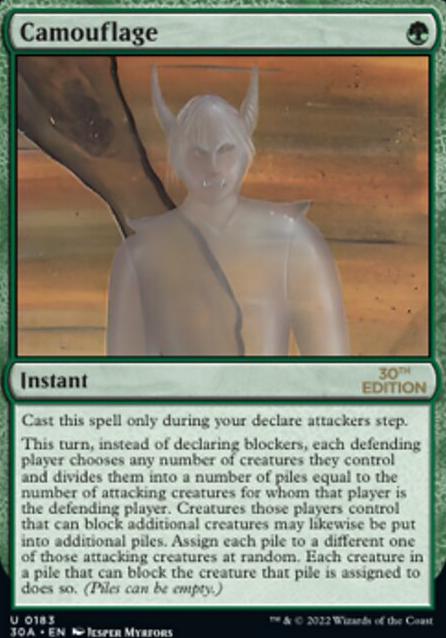
Caerwyn on Karona, Destroyer of Worlds
4 years ago
Karona, False God is one of my all-time favourite cards. Sure, she's terrible, and her ability is prone to backfiring... but she's so wonderfully unique that I fell in love with her when I opened her way back in the day.
First off, let's deal with the biggest problem your card design has--there is just way too much text as proposed. As it stands, you're at 118 words spread across four paragraphs (breaks between paragraphs take up additional space). That's even more wordy than the notoriously lengthy Camouflage 's 98 words across two paragraphs.
Now, onto the main point of trying to fix Karona. Coming from the perspective of someone who plays a casual-oriented Karona Voltron list, I'll talk about my own concerns and suggestions.
To start, Karona has three major problems. The first is that she can easily backfire on you, either by swinging at you as a 5+/5+ or pumping an enemy tribe substantially (which can kill you even of you are using Vow of Wildness to avoid her attacking you). The second problem is that there is little incentive to attack with her unless you're running tribal, other than working together to quickly wrack up your 21 commander damage on someone. Finally, she is really easy to remove--not only is she vulnerable to your classic removal package, she also can be sacrificed when under the control of another player or her controller can willingly charge her into a more powerful/deathtouch blocker.
Your chosen suggestions fix some of these problems--the evasion and widening the boon to all creatures (rather than of a certain type) certainty is a better reason to swing. The free casting further provides an incentive to attack.
However, that means you're using two abilities to solve one of the three problems--that's not exactly ideal. Instead, perhaps:
-
Haste, Indestructible
-
At the beginning of each player’s upkeep, that player untaps Karona, Destroyer of Worlds and gains control of it.
-
Whenever Karona attacks, if no creatures are attacking Karona’s owner, creatures you control get +3/+3 until end of turn.
That's not too different from the original, and probably could keep the same mana cost. The anthem effect is a bit more powerful (seeing as it hits all creatures) encouraging using her offensively, but has a built-in protection for her owner. Indestructible makes it harder to kill her through blocking, but still leaves her open to exile and sacrifice effects, so there are still design flaws to build around (since that's kind of what makes her fun!).
Rhadamanthus on Gorm the Great + Raving …
4 years ago
To be clear: I never said Camouflage had you skip the declare blockers step. I said it made you skip the act of declaring blockers. I was using the word "skip" in the colloquial sense rather than the strict Comprehensive Rules sense and maybe I shouldn't have done that.
I'm not convinced menace is one of the things that gets considered when deciding what creatures "could block" the attacker in the case of Camouflage but I understand the arguments for both sides. I'll retract what I said about menace earlier and leave it for more official sources to decide (I'm really surprised the Gatherer entry for Camouflage doesn't already have a rulings note about it).
Boza on Gorm the Great + Raving …
4 years ago
I will try and summarize all the discussion so far:
-
Gorm the Great does not have menace. If it did, it would have to be blocked by two creatures. But as he is, he can be blocked by a single creature.
-
Camouflage can be a pain in the ... head ... to try and wrap your head around it.
Kogarashi on Gorm the Great + Raving …
4 years ago
Camouflage is replacing the normal act of declaring blockers (defending player chooses which creatures block and what they're blocking) with its replacement (defending player makes piles of creatures, attacking player randomly assigns piles to attackers). Restrictions aren't considered until the point of "each creature in a pile that can block the creature that pile is assigned to does so."
Flying, Intimidate, Shadow, etc. all restrict whether a creature can block its randomly assigned attacker because they're evasion abilities. So is Menace.
-
702.110a Menace is an evasion ability.
-
702.110b A creature with menace can’t be blocked except by two or more creatures. (See rule 509, “Declare Blockers Step.”)
The second rule above alone should be enough to say that if a pile with only one creature was assigned to the creature with Menace, then the Menace creature is unblocked because it can't be blocked unless there are two or more creatures in the pile.
In the normal order of declaring blockers, the defending player would assign blockers to attackers, then check for restrictions (rule 509.1b). If any restrictions are being disobeyed, the declaration of blockers is illegal. The point where Camouflage says creatures in each pile block their attacker if able is where the restrictions should be checked (such as whether or not a blocker has Shadow, Flying, Reach, or is the right colors/type for Fear/Intimidate). This is also where it should check if there are enough creatures to block the creature with Menace. If there is only one, it can't actually block the creature with Menace because it doesn't meet the requirement (have two or more creatures capable of blocking). It's not strictly looking for a quality of the creature, but the evasion ability should still apply.
And I can certainly see why Camouflage hasn't been reprinted any time recently.
Sarkhan420X on Gorm the Great + Raving …
4 years ago
dragonstryke58: false. menace is not a restriction on "what" can block, but "how" a creature can block. my example applies perfectly. because the Vivid Crag "could" create mana of any color (if it had the counter), just like any creature "could" block something with menace, (if something blocks alongside it). the rules you reference in no way, shape, or form, gives any sort of restriction of any kind whatsoever on "what" can block something with menace, only "how". please learn the difference between "what" and "how".
with flying however, there are zero conditions of any kind that could allow a non-flying/non-reach creature to block something with flying. this makes it very different to menace.
also note that "can block" and "can be declared as a blocker" are 2 different things. menace cares about "declaring" blockers. even if a creature blocked by only 1 defending creature gains menace after blockers are declared, the creature is still considered blocked and nothing changes. that right there definitively proves that if a creature with menace is blocked by a 1-creature pile due to Camouflage , it remains blocked.
dragonstryke58 on Gorm the Great + Raving …
4 years ago
The reason (and it may be a bad reason) I said that Camouflage doesn't skip the declare blockers step and instead modifies it is because the turn does not go directly from the declare attackers step to the combat damage step. You still have to finish the declare attacker step, passing priority to move to the next step or phase. However, the next step is not the combat damage step as would happen if you skipped the declare blockers step. You would need to apply the replacement ability created by Camouflage .
506.1. The combat phase has five steps, which proceed in order: beginning of combat, declare attackers, declare blockers, combat damage, and end of combat. The declare blockers and combat damage steps are skipped if no creatures are declared as attackers or put onto the battlefield attacking (see rule 508.8). There are two combat damage steps if any attacking or blocking creature has first strike (see rule 702.7) or double strike (see rule 702.4).
You cannot say that you apply the effect of Camouflage on either the declare attackers or combat damage step because that is not the step you would declare blockers.
Also, like one of the most used explanations in MTG says: "Things in Magic do exactly what they say." In this case, I reason that Camouflage does not skip the declare blockers step since it does not say "skip". It uses "instead" which is a replacement effect that modifies the event occurring. Camouflage replaces the declaration of blocker with another event not skips the declare blockers step altogether.
614.1a Effects that use the word “instead” are replacement effects. Most replacement effects use the word “instead” to indicate what events will be replaced with other events.
614.1b Effects that use the word “skip” are replacement effects. These replacement effects use the word “skip” to indicate what events, steps, phases, or turns will be replaced with nothing.
Kogarashi on Gorm the Great + Raving …
4 years ago
For what it's worth, a quick Google search for Camouflage 's interactions with menace pulled up this quote (from Stackexchange, but quoting someone asking on a Magic Judge tumblr):
- I asked this question to the (Unofficial) Ask a Magic Judge tumblr blog worded like this: "Say Anthony attacks with a Charging Rhino and Boggart Brute, then casts Camouflage. Then, while declaring blocks, Nathan puts 2 vanilla creatures in one pile and 1 in the other. Unfortunately, he gets unlucky, and the pile with 2 creatures is assigned to block Charging Rhino and the pile with 1 creature is assigned to block Boggart Brute. Which creatures end up blocked, and why does it work that way?" and this is the response: "Neither creature is blocked because neither set of blockers is legal."
So menace should probably still require a legal set of blockers (2 or more), even though blockers aren't declared, if intimidate and flying are also considered for this. Basically if a creature with menace is assigned a pile with only one creature, too bad, that's not a legal block for the menace creature.
Gorm the Great doesn't count in this situation since he doesn't actually have menace, just an "if able" condition. The implication there is "if unable, then block normally."
Sarkhan420X on Gorm the Great + Raving …
4 years ago
i don't think you're understanding what Rhadamanthus is saying. flying and menace are not comparable in the way you are trying to compare them. you're basically making a false equivalency. creatures with flying can only be blocked by creatures with flying. menace however, does not actually "restrict what can block it" as you say. ANY creature "can" block an attacking creature with menace.
Camouflage literally does skip the declare blockers step. Rhadamanthus already explained this when he stated the oracle text says "INSTEAD of declaring blockers...". this means Camouflage DOESN'T "modify" how blockers are being declared, because they AREN'T being declared. and thats what menace cares about. declaring blockers.




